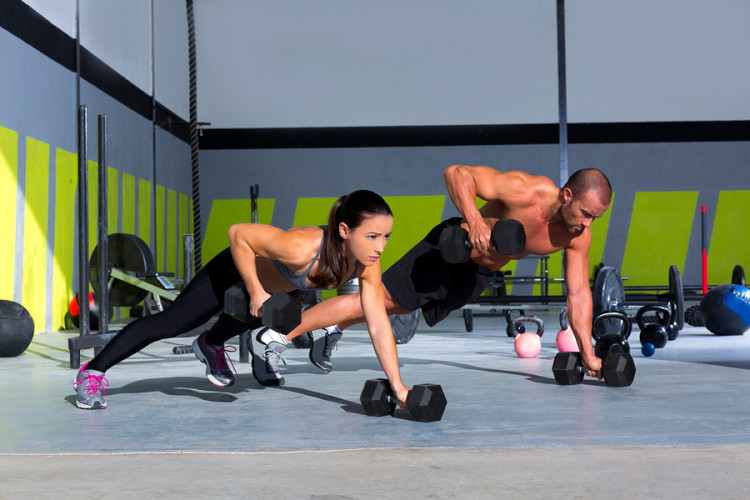Optimize Your Performance by Preparing Your Muscles for Intense Workouts

by Dickson Okorafor May 21, 2023
If you’re looking to optimize your performance during intense workouts, then it’s crucial to prepare your muscles properly beforehand. Muscle preparation refers to the process of getting your muscles ready for the demands that will be placed on them during exercise. This can involve a variety of activities, such as stretching, foam rolling, or performing dynamic warm-up exercises.
The importance of muscle preparation before intense workouts cannot be overstated. Without proper preparation, your muscles may not be able to perform at their best, which can lead to decreased strength, power, and endurance. Additionally, failing to prepare your muscles can increase your risk of injury, which can set you back in your training and even sideline you completely.
But the benefits of muscle preparation go beyond just preventing injury and improving performance. When you prepare your muscles properly, you also increase blood flow and oxygen delivery to the muscles, which can enhance their ability to contract and produce force. This, in turn, can lead to greater gains in muscle size, strength, and power over time.
We’ll explore the best practices for muscle preparation before intense workouts, as well as some specific techniques and exercises that you can use to get your muscles ready for action. So if you’re ready to take your workouts to the next level and maximize your gains, keep reading!
Understanding Your Body
Firstly, it’s important to understand that everyone’s body is unique, and there are three main body types: ectomorph, mesomorph, and endomorph.
Ectomorphs tend to have a lean build, with narrow hips and shoulders, long limbs, and low body fat. They may find it difficult to build muscle mass and often have a fast metabolism.
Mesomorphs are typically muscular and athletic, with a medium-sized bone structure, broad shoulders, and narrow waist. They have a natural ability to gain muscle and lose fat easily.
Endomorphs have a larger bone structure and carry more body fat, with a rounder shape and wider hips. They may struggle to lose weight and find it harder to build muscle mass.
When it comes to preparing your muscles for intense workouts, it’s important to tailor your approach based on your body type.
For ectomorphs, focus on compound exercises that work multiple muscle groups at once, such as squats, deadlifts, and bench presses. Make sure to incorporate enough rest and recovery time, as ectomorphs may need more time to recover between workouts.
Mesomorphs can handle more intense workouts and may benefit from incorporating high-intensity interval training (HIIT) or plyometric exercises into their routine. Focus on challenging your muscles with heavier weights and shorter rest periods.
For endomorphs, it’s important to prioritize cardio and weightlifting to help build lean muscle mass and burn fat. Incorporate a mix of resistance training and high-intensity cardio, such as sprints or hill training, to maximize results.
Regardless of your body type, it’s important to listen to your body and adjust your workouts accordingly. Don’t push yourself too hard too quickly, and make sure to warm up and cool down properly to prevent injury.
Remember, the key to optimizing your performance is understanding your body and tailoring your approach to your unique needs and goals. With the right preparation and training, you can achieve your fitness goals and improve your overall health and well-being.
Pre-workout nutrition
When it comes to optimizing your performance during intense workouts, pre-workout nutrition is a crucial factor that cannot be overlooked. The food and supplements you consume before exercising can significantly impact your energy levels, endurance, strength, and overall performance. Let’s dive into the importance of pre-workout nutrition, some foods that help with muscle preparation, and supplements that aid in muscle preparation.
- Importance of Pre-Workout Nutrition
Pre-workout nutrition provides your body with the necessary fuel to power through your workouts. Consuming the right nutrients before exercising can help enhance your performance, reduce fatigue, and prevent muscle damage. Moreover, it can help you maximize your gains by supporting muscle growth and repair.
- Foods that Help with Muscle Preparation
Carbohydrates: Consuming carbohydrates before exercising can help improve your endurance and performance. Carbs are the primary fuel source for
high-intensity workouts, and they help maintain blood sugar levels, preventing fatigue. Some good sources of carbohydrates include fruits, whole grains, oatmeal, and sweet potatoes.
- Protein
Protein is essential for muscle growth and repair. Consuming protein before exercising can help reduce muscle damage, increase muscle protein synthesis, and improve recovery. Some good sources of protein include lean meat, poultry, fish, eggs, and legumes.
- Fats
Consuming healthy fats before exercising can help provide a slow-release energy source, keeping you fueled throughout your workout. Some good sources of healthy fats include nuts, seeds, avocado, and olive oil.
Supplements that Aid in Muscle Preparation
- Creatine
Creatine is one of the most popular and effective supplements for muscle growth and performance. It helps increase muscle strength, power, and endurance, allowing you to push harder during your workouts.
- Caffeine
Caffeine is a natural stimulant that can help improve focus, alertness, and energy levels. It also helps increase fat burning, making it a popular supplement for weight loss and muscle building.
- Beta-Alanine
Beta-alanine is an amino acid that helps reduce muscle fatigue and improve endurance. It works by buffering lactic acid, a compound that builds up in
your muscles during high-intensity exercise.
Pre-workout nutrition is a vital aspect of optimizing your performance during intense workouts. By consuming the right nutrients and supplements, you can increase your energy levels, endurance, and strength, ultimately maximizing your gains. So, make sure to fuel your body with the right foods and supplements before hitting the gym.
Warm-up exercises
Warm-up exercises are an essential part of any exercise routine, regardless of whether you’re a beginner or an experienced athlete. They’re important because they help prepare your muscles for the demands of intense physical activity, reduce the risk of injury, and improve your overall performance.
There are several types of warm-up exercises that you can incorporate into your routine, including:
- Dynamic stretching
This involves moving your body through a range of motions to help increase blood flow, flexibility, and mobility. Examples of dynamic stretches include lunges, leg swings, and arm circles.
- Aerobic exercise
This type of warm-up involves getting your heart rate up by engaging in low- to moderate-intensity cardio activities, such as jogging, jumping jacks, or cycling.
- Plyometric exercises
These are explosive, high-intensity movements that involve jumping, hopping, or bounding. They help to activate your fast-twitch muscle fibers and
- Sport-specific drills
If you’re preparing for a particular sport or activity, incorporating drills that mimic the movements and demands of that sport can be a great way to warm up your body and prepare your mind for the activity ahead.
To perform warm-up exercises effectively, it’s important to start slowly and gradually increase the intensity as your body warms up. You should aim to spend at least 10-15 minutes warming up before beginning your main workout.
When performing dynamic stretching exercises, make sure to move slowly and smoothly through the full range of motion, without bouncing or jerking. It’s also important to avoid static stretching (holding a stretch for an extended period) during your warm-up, as this can actually decrease your muscle power and increase your risk of injury.
If you’re doing aerobic exercise, start with a low-intensity activity, such as walking or slow cycling, and gradually increase the intensity until you’re working at a moderate intensity level. You should be breathing a little harder than normal, but still able to carry on a conversation.
When incorporating plyometric exercises, make sure to start with low-impact variations and gradually increase the intensity and difficulty as your body becomes more warmed up.
Warm-up exercises are an important part of any exercise routine, as they help to prepare your body for the demands of physical activity and reduce the risk of injury. By incorporating a variety of dynamic stretching, aerobic, plyometric, and sport-specific drills, and gradually increasing the intensity as your body warms up, you can optimize your performance and get the most out of your workouts.
Stretching
Stretching is an essential aspect of any workout routine, as it helps to prepare your muscles for intense physical activity. In this article, we will explore the different types of stretching, their benefits, and some examples of stretching exercises that you can incorporate into your routine.
Types of Stretching
There are several different types of stretching, including static stretching, dynamic stretching, PNF stretching, and foam rolling. Each type of stretching has its own unique benefits and can be used in different situations.
Static Stretching
Static stretching involves holding a stretch in a stationary position for a set period of time. This type of stretching is great for increasing flexibility and range of motion, as well as reducing the risk of injury. Examples of static stretches include the hamstring stretch, quad stretch, and calf stretch.
- Dynamic Stretching
Dynamic stretching involves moving your muscles through a range of motion in a controlled manner. This type of stretching is great for warming up your muscles and preparing them for more intense activity. Examples of dynamic stretches include walking lunges, high knees, and leg swings.
- PNF Stretching
PNF stretching, or proprioceptive neuromuscular facilitation, involves a combination of contracting and relaxing muscles to increase flexibility. This type of stretching is often used in rehabilitation settings to help patients recover from injuries. Examples of PNF stretches include the contract-relax method and the hold-relax method.
- Foam Rolling
Foam rolling is a type of self-myofascial release that involves using a foam roller to apply pressure to your muscles. This can help to release tension and improve flexibility. Foam rolling can be done before or after a workout, or even on rest days.
Benefits of Stretching
Stretching has several benefits, including
- Increased Flexibility
Stretching can help to increase your range of motion, allowing you to move more freely and with less pain.
- Improved Performance
Stretching can help to improve your overall athletic performance by preparing your muscles for intense activity.
- Reduced Risk of Injury
Stretching can help to reduce the risk of injury by preparing your muscles for physical activity and improving their flexibility.
- Improved Posture
Stretching can help to improve your posture by correcting muscle imbalances and reducing tension in your muscles.
Examples of Stretching Exercises
Here are some examples of stretching exercises that you can incorporate into your routine:
- Hamstring Stretch
Sit on the floor with your legs straight out in front of you. Reach forward and try to touch your toes, keeping your legs straight.
- Quad Stretch
- Stand with your feet hip-width apart. Bend your right knee and lift your foot behind you, grabbing your ankle with your right hand. Hold for 30 seconds, then switch sides.
- Calf Stretch
- Stand facing a wall with your hands on the wall at shoulder height. Step back with your left foot and press your heel into the ground. Hold for 30 seconds, then switch sides.
- Walking Lunges
- Take a large step forward with your right foot and lower your body until your right knee is bent at a 90-degree angle. Push off your right foot to stand up, then repeat with your left foot.
- Stretching is an essential component of any workout routine, as it helps to prepare your muscles for intense physical activity. By incorporating stretching exercises into your routine, you can improve your flexibility, reduce the risk of injury, and improve your overall athletic performance. So, take some time to stretch before and after your workouts and see the difference it can make in your performance.
- Foam rolling
- Foam rolling has become increasingly popular in recent years as a way to improve flexibility, increase circulation, and reduce muscle soreness. In this article, we’ll explore what foam rolling is, the benefits of foam rolling, and how to use a foam roller effectively.
- What is Foam Rolling ?
- Foam rolling is a self-myofascial release (SMR) technique that uses a foam roller to apply pressure to specific areas of the body. Myofascial release refers to the process of applying pressure to trigger points, or knots, in the muscles and connective tissue to relieve tension and improve range of motion.
- Benefits of Foam Rolling
- There are many benefits of foam rolling, including:
- Improved Flexibility
- Foam rolling can help improve flexibility by breaking up adhesions and scar tissue in the muscles and connective tissue. This can lead to increased range of motion and improved performance.
- Increased Circulation
- Foam rolling can help increase blood flow to the muscles, which can improve recovery and reduce muscle soreness.
- Reduced Muscle Soreness
- Foam rolling can help reduce muscle soreness by breaking up adhesions and scar tissue in the muscles, which can improve recovery time.
- Improved Posture
- Foam rolling can help improve posture by releasing tension in the muscles that can cause poor posture.
- How to Use a Foam Roller Effectively
- To use a foam roller effectively, follow these steps:
- Find a flat, open area
- Find a flat, open area where you can lie down and roll out your muscles.
- Identify the area to be rolled
- Identify the area of your body that you want to target. Start with the larger muscle groups such as the quadriceps, hamstrings, calves, and back.
- Position the foam roller
- Position the foam roller under the targeted muscle group.
- Apply pressure
- Use your body weight to apply pressure to the foam roller and roll back and forth over the targeted muscle group.
- Target specific areas
- If you find a particularly tender spot, pause and apply more pressure to that area until you feel the tension release.
- Repeat on other areas
- Repeat the process on other areas of your body.
- Conclusion
- Foam rolling is an effective technique for improving flexibility, increasing circulation, and reducing muscle soreness. By using a foam roller effectively, you can target specific areas of your body to improve your performance and overall well-being. So, grab a foam roller and start rolling your way to better health and fitness!
- Resistance band exercises
- Resistance band exercises are a great way to strengthen and tone your muscles without the need for expensive equipment or a gym membership. These elastic bands come in a variety of colors, lengths, and strengths, making them suitable for people of all fitness levels and ages. Resistance band exercises are a great way to strengthen and tone your muscles using a stretchy band that provides resistance. The resistance of the band challenges your muscles, making them work harder than they would without the band.
- One of the main benefits of resistance band exercises is that they allow you to target specific muscle groups and work them in isolation. This is particularly useful for people who are recovering from an injury or have a muscle imbalance that needs correcting. Resistance band exercises are also great for improving your range of motion, flexibility, and joint mobility.
- They are incredibly versatile. You can use them for a wide range of exercises that target different muscle groups, from your arms and shoulders to your legs and glutes. They are also lightweight and portable, so you can take them with you anywhere and use them at home, at the gym, or even while you’re traveling. They are relatively inexpensive and can be purchased online or at most fitness stores
- Another benefit of resistance band exercises is that they are low-impact, which makes them an excellent option for people who want to avoid putting too much strain on their joints. They can also be used to add variety to your workout routine and can be easily modified to increase or decrease the resistance, depending on your fitness level.
- Some popular resistance band exercises include bicep curls, tricep extensions, shoulder presses, squats, lunges, and glute bridges. By adjusting the band’s tension, you can increase or decrease the resistance level to challenge your muscles at various levels.
- Let’s take a look at some examples of resistance band exercises that you can try:
- Bicep curls
- Stand on the middle of the resistance band with your feet shoulder-width apart. Hold the ends of the band with your palms facing up and slowly curl the band towards your shoulders, squeezing your biceps as you go.
- Squats
- Place the resistance band above your knees and stand with your feet shoulder-width apart. Push your hips back and lower yourself into a squat, keeping your chest up and your knees in line with your toes.
- Lateral raises
- Stand on the middle of the resistance band and hold the ends with your palms facing down. Lift your arms out to the sides until they are parallel with the ground, squeezing your shoulders as you go.
- Glute bridges
- Lie on your back with the resistance band above your knees. Bend your knees and place your feet flat on the ground. Lift your hips up towards the ceiling, squeezing your glutes at the top of the movement.
- Resistance band exercises are an excellent way to add variety to your workout routine and challenge your muscles in new ways. Whether you’re a beginner or a seasoned athlete, there are plenty of resistance band exercises that can help you achieve your fitness goals. So go ahead, give them a try and see how they can help you optimize your performance!
- Hydration
- Hydration is an essential component of preparing your muscles for intense workouts. Without adequate hydration, your muscles may not function optimally, leading to decreased performance, increased risk of injury, and longer recovery times. In this response, I will discuss the importance of
- hydration for muscle preparation and how much water you should drink before a workout.
- When it comes to hydration, your muscles rely on water to function properly. Water is necessary for the transport of nutrients and oxygen to your muscles, which allows them to produce energy and perform at their best. Additionally, water helps regulate your body temperature, which is essential during exercise to prevent overheating and dehydration.
- So, how much water should you drink before a workout? The answer depends on a few factors, including your body weight, the intensity and duration of your workout, and the temperature and humidity of your environment. A general guideline is to aim for at least 17 to 20 ounces of water two to three hours before exercising, and then another 8 ounces 20 to 30 minutes before starting your workout. However, if you are exercising in hot or humid conditions, you may need to increase your fluid intake to prevent dehydration.
- It’s important to note that thirst is not always a reliable indicator of your hydration status. By the time you feel thirsty, you may already be dehydrated. Therefore, it’s a good idea to drink water regularly throughout the day to ensure that your body is adequately hydrated before you even start your workout.
- In addition to drinking water, you can also hydrate your muscles by incorporating exercises that promote fluid circulation. One example is foam rolling, which is a form of self-massage that can help increase blood flow and hydration to your muscles. Another option is dynamic stretching, which involves moving through a range of motion to increase blood flow and prepare your muscles for exercise.
- Hydration is crucial for muscle preparation and optimal performance during intense workouts. To ensure that your muscles are adequately hydrated, drink water regularly throughout the day, and aim for at least 17 to 20 ounces of water two to three hours before exercising, and then another 8 ounces 20 to 30 minutes before starting your workout. Don’t forget to incorporate exercises that promote fluid circulation, such as foam rolling and dynamic stretching, to further enhance muscle hydration and preparation.
- Conclusion
- Recap of the Importance of Muscle Preparation
- In conclusion, muscle preparation is a critical step for anyone looking to optimize their performance during intense workouts. By properly warming up and stretching your muscles beforehand, you can increase blood flow to the area, improve flexibility and range of motion, and reduce the risk of injury. Additionally, incorporating dynamic movements and exercises that target the specific muscle groups you’ll be working can help activate those muscles and prepare them for the demands of your workout.
- Final Thoughts and Recommendations
- If you’re serious about getting the most out of your workouts, it’s essential to make muscle preparation a regular part of your routine. A good warm-up should take about 10-15 minutes and should include some light cardio, stretching, and dynamic movements that mimic the exercises you’ll be doing during your workout. It’s also a good idea to invest in some foam rollers or other tools that can help you massage and stretch your muscles more effectively.
- Remember, the goal of muscle preparation isn’t just to prevent injury (although that’s certainly important!). It’s also about priming your body for peak performance so you can push yourself harder and achieve your fitness goals more quickly. So take the time to prepare your muscles properly before every workout, and you’ll be amazed at how much of a difference it can make.
- Muscle preparation is a vital component of any effective workout regimen. By taking the time to warm up, stretch, and activate your muscles before you start your workout, you can reduce the risk of injury, improve your performance, and achieve your fitness goals more quickly. So don’t skip this important step – make muscle preparation a priority in your fitness routine!
- Dickson Okorafor is a blogger and writer with over ten years of experience in the health and beauty niche. He has been writing for many websites and publications. When I’m not writing, I enjoy reading health, fitness, and beauty materials, including taking part in related community activities. As a content creator, you can learn more or get a support product by clicking on this link, https://nplink.net/lmt1kbz
- articlebiz.com







No Comment